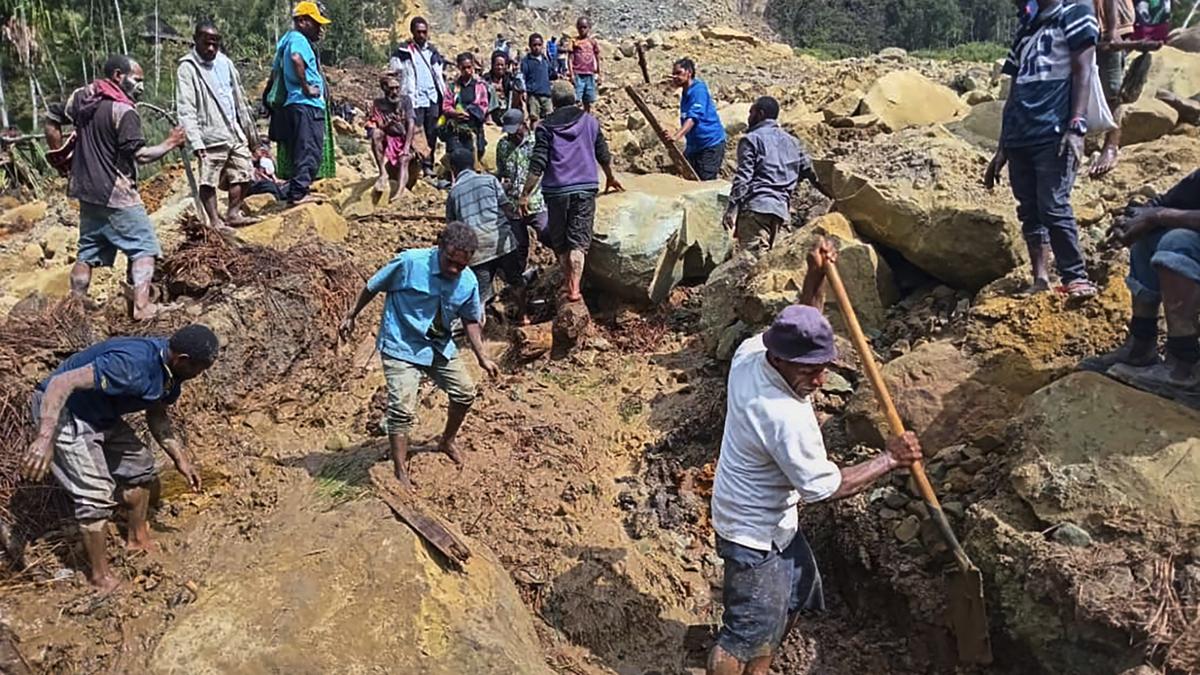- May 28, 2024
7,900 People Evacuated Under New Landslide Threat: Papua New Guinea

A vast smear of yellow and grey debris can be seen cutting through verdant bushland.
Port Moresby, Papua New Guinea:
Papua New Guinea moved to evacuate an estimated 7,900 people from remote villages near the site of a deadly landslide on Tuesday, as authorities warned of further slips.
Some 2,000 people are already feared buried in a landslide that destroyed a remote highland community in the early hours of May 24.
With rescue and relief efforts hampered by the remote location, a severed road link, heavy rainfall and nearby tribal violence, Enga provincial administrator Sandis Tsaka warned the disaster could yet worsen.
Tsaka said authorities were trying to coordinate the evacuation of almost 7,900 people as clumps of limestone, dirt and rock continue to shear off Mount Mungalo.
“The tragedy is still active,” he told AFP. “Every hour you can hear rock breaking — it is like a bomb or gunshot and the rocks keep falling down.”
Satellite images from Monday showed the enormous scale of the disaster.
A vast smear of yellow and grey debris can be seen cutting through verdant bushland and severing the region’s only road.
For four days and nights, locals have been picking through a hellscape of metres-deep churned-up earth, uprooted trees and car-sized boulders, using little more than shovels and digging sticks.
“This was an area heavily populated with homes, businesses, churches and schools, it has been completely wiped out. It is the surface of the moon — it is just rocks,” said Tsaka.
“People are digging with their hands and fingers,” he said, expressing anguish at the unde-resourced government’s inability to meet the enormity of the disaster.
“I am not equipped to deal with this tragedy,” Tsaka admitted.
The Papua New Guinea Defence Forces are trying to access the site with heavy earth-moving equipment.
It is increasingly unlikely that they will find survivors, and so rescuers are now turning to the grim task of body recovery.
Overwhelmed Papua New Guinea authorities were holding an online emergency meeting with United Nations agencies and international allies Tuesday, hoping to kickstart the relief effort.
‘Immediate’ response needed
Papua New Guinea’s national disaster centre has told the United Nations that the initial “landslide buried more than 2,000 people alive”.
According to a letter obtained by AFP, the slide also “caused major destruction to buildings, food gardens and caused major impact on the economic lifeline of the country.”
The scale of the catastrophe required “immediate and collaborative actions from all players”, it added, including the army, and national and provincial responders.
Australia has announced millions of dollars worth of aid, including emergency relief supplies such as shelters, hygiene kits and support for women and children.
China’s President Xi Jinping and his US counterpart Joe Biden — more accustomed to scrapping for influence in strategically located Papua New Guinea — both offered assistance.
More than 1,000 people have already been displaced by the catastrophe, aid agencies have estimated.
‘Houses are burning’
Locals said the landslip may have been triggered by recent heavy rains.
Papua New Guinea has one of the wettest climates in the world, and research has found shifting rainfall patterns linked to climate change could exacerbate the risk of landslides.
The death toll has been climbing since the disaster struck as officials reassess the size of the population lying beneath mud and rubble spanning almost four football fields in length.
Estimating the toll is difficult because many people fleeing tribal violence have moved into the area in the past few years, said UN Development Programme official Nicholas Booth.
Five bodies and the leg of a sixth had been pulled from the debris by Saturday night.
An outbreak of tribal fighting unrelated to the disaster was blocking attempts to bring in humanitarian aid from the provincial capital Wabag, the UN migration agency official Serhan Aktoprak said.
“Many houses are burning with others emitting smoke. Women and children have been displaced while all the youth and men in the area were carrying bush knives,” he said, quoting from a report from an aid convoy attempting to reach the disaster site.
The area is located about 600 kilometres (370 miles) from Port Moresby.
(Except for the headline, this story has not been edited by NDTV staff and is published from a syndicated feed.)







